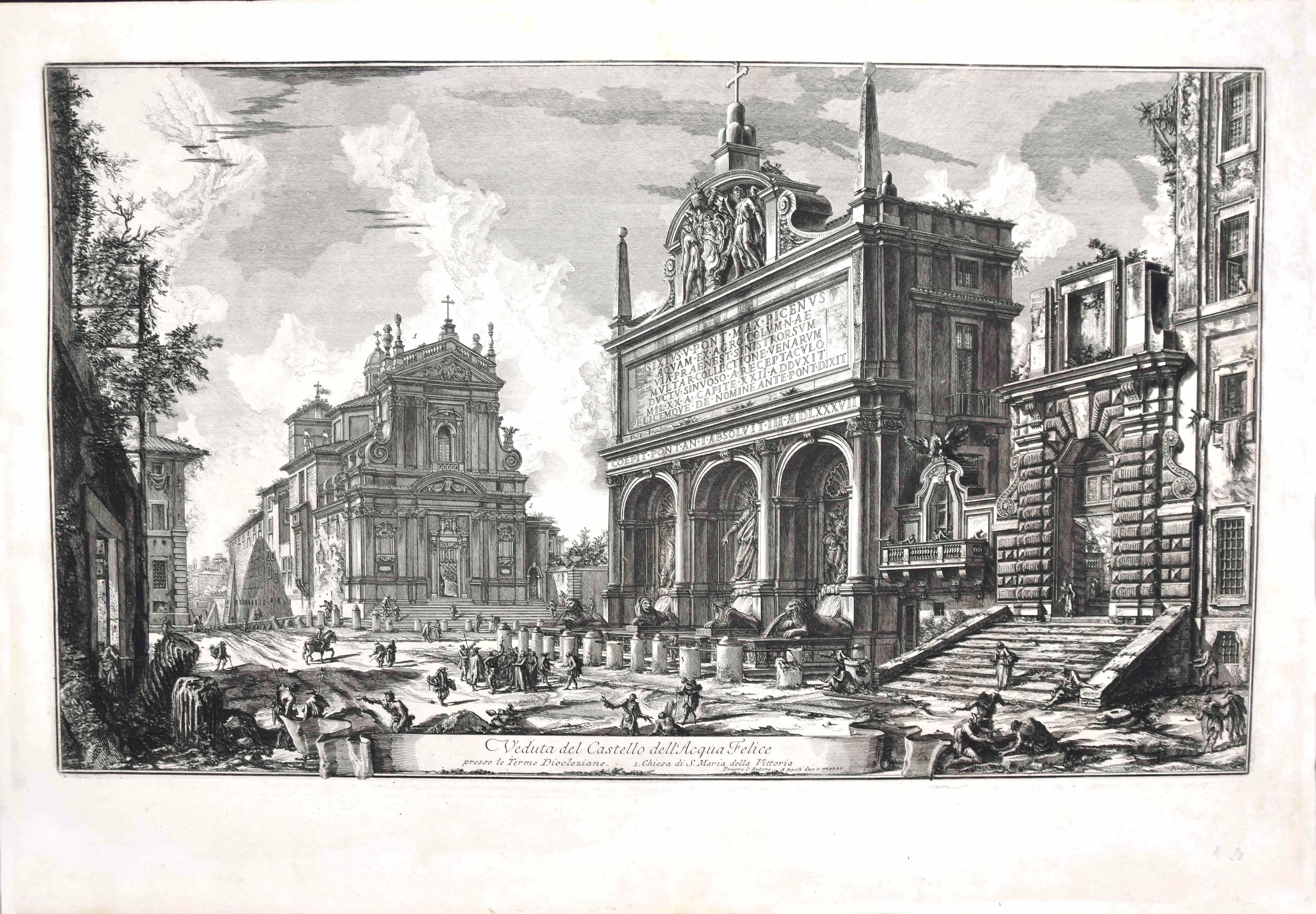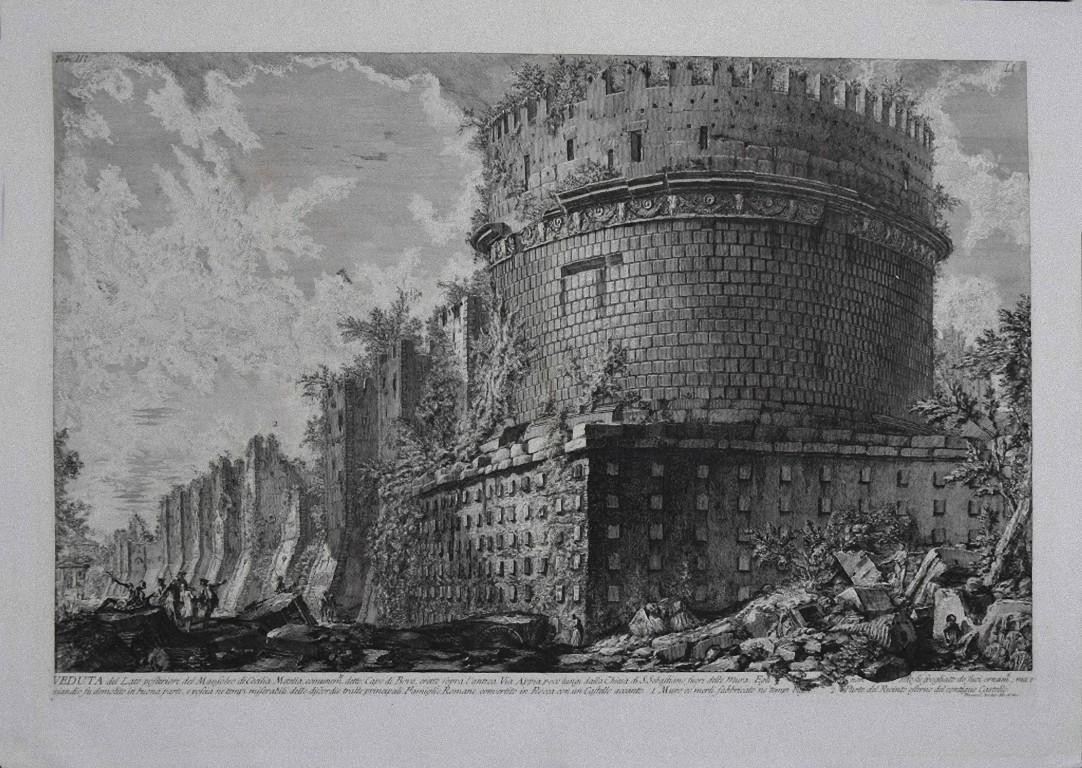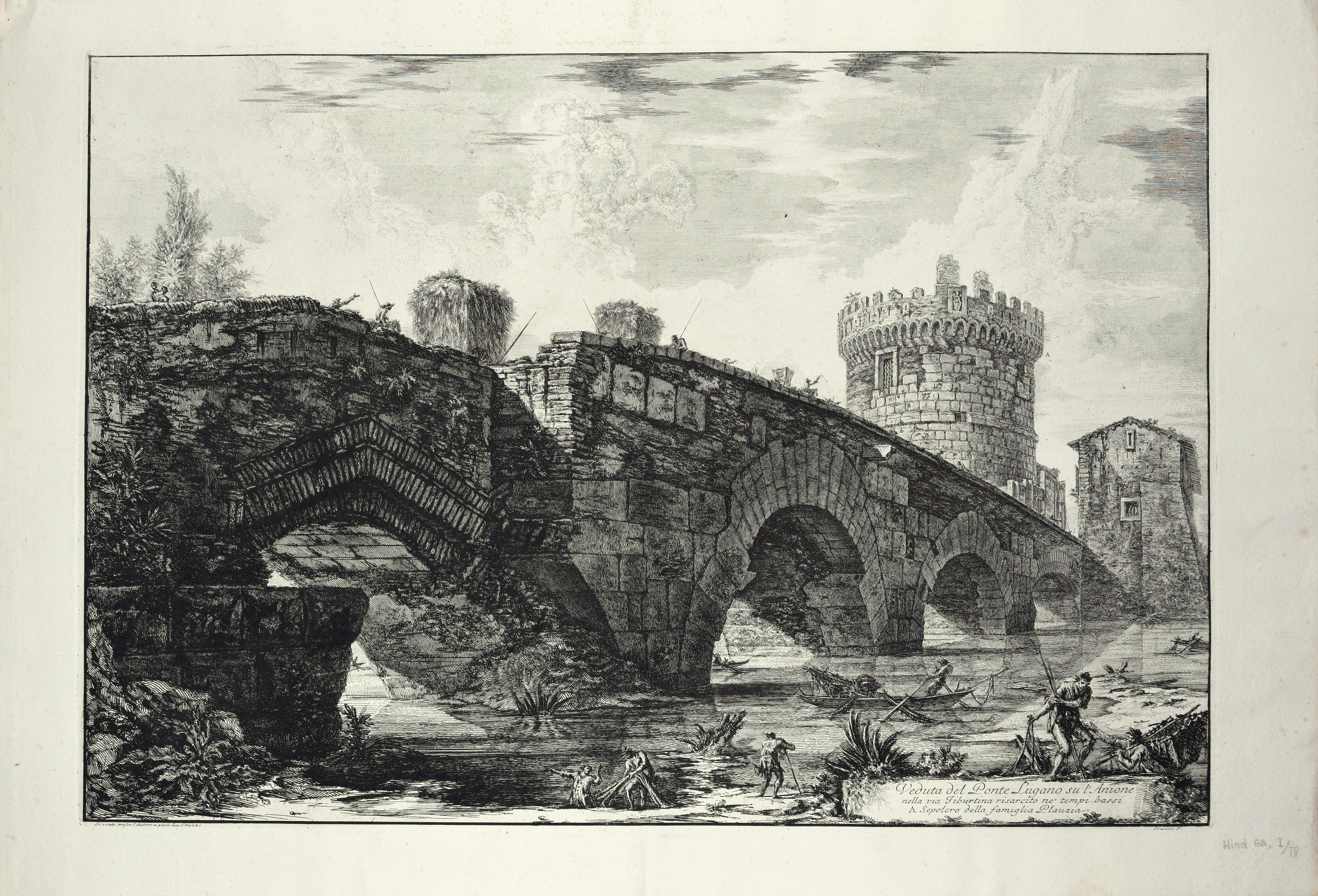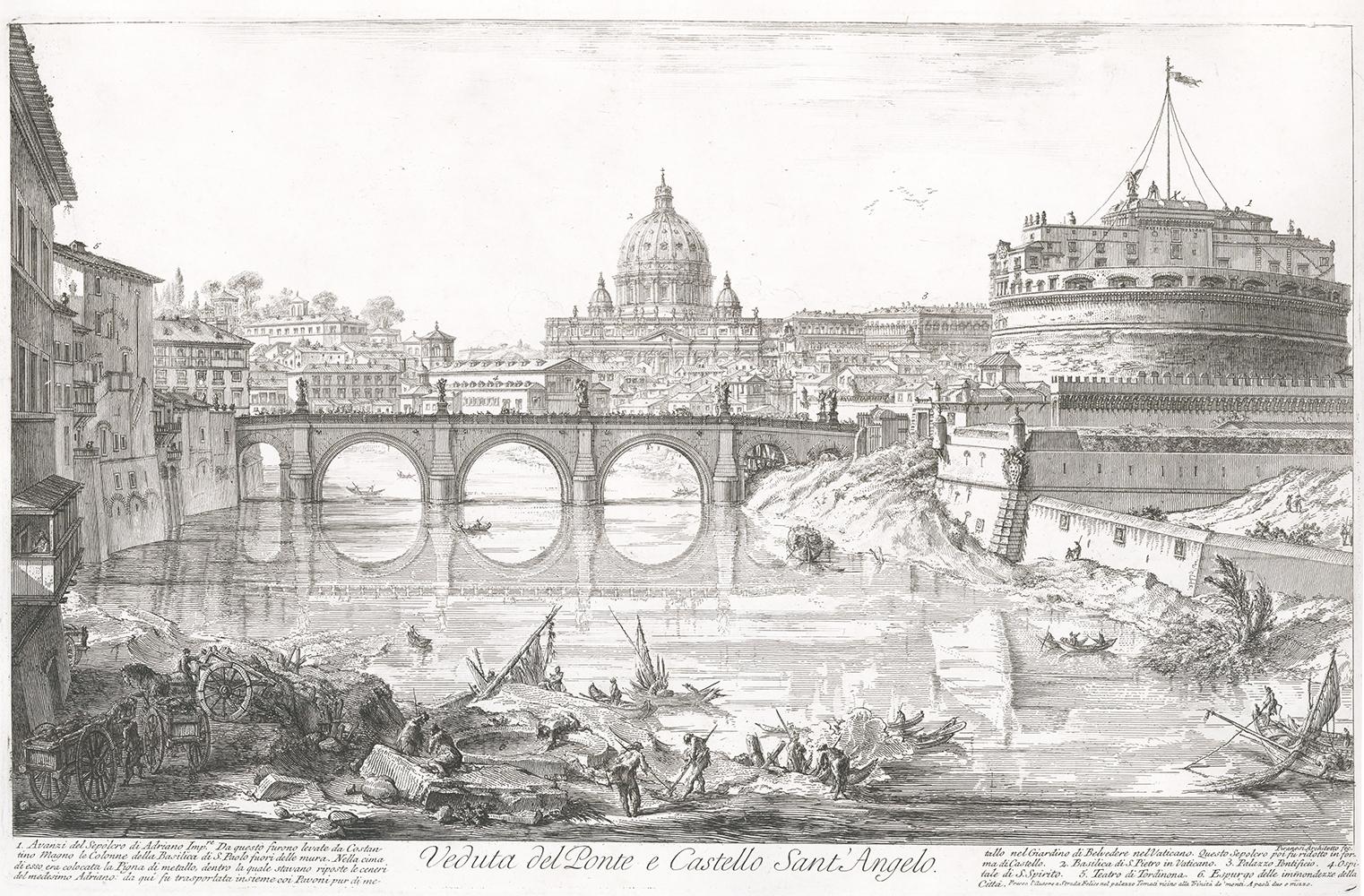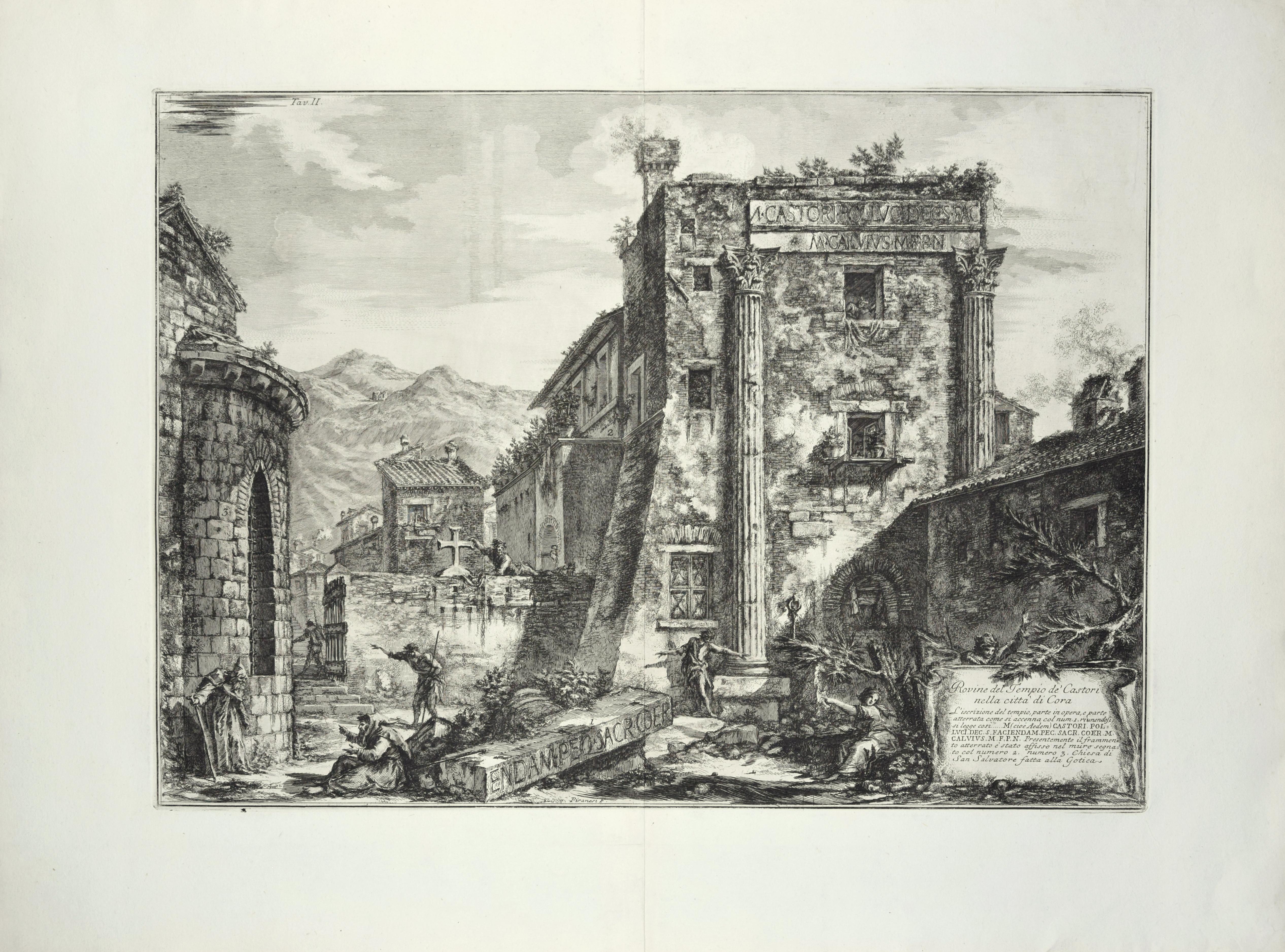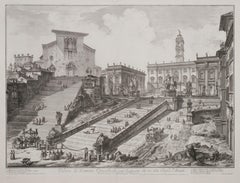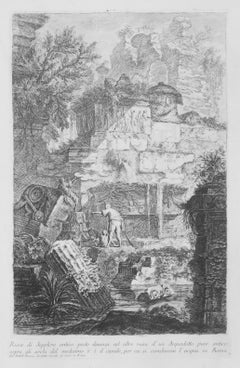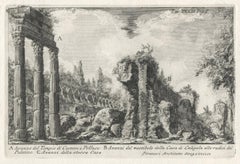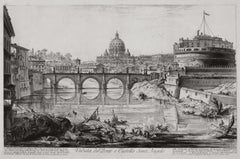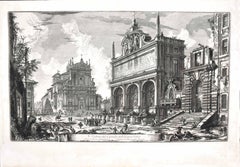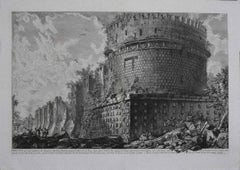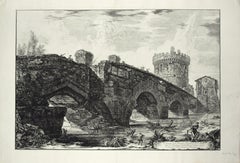Items Similar to View of the Ancient Structure built by Tarquinius Superbus called the Bel Lido
Want more images or videos?
Request additional images or videos from the seller
1 of 10
Giovanni Battista PiranesiView of the Ancient Structure built by Tarquinius Superbus called the Bel Lido1750-1778
1750-1778
$2,750
£2,059.35
€2,374.64
CA$3,865.25
A$4,222.77
CHF 2,215.25
MX$51,375.23
NOK 27,558.71
SEK 26,093.44
DKK 17,727.12
About the Item
View of the Ancient Structure built by Tarquinius Superbus called the Bel Lido, and like others built by Marcus Agrippa in the time of Augustus when he cleaned all the sewers leading to the Tiber [The Cloaca Maxima], from Vedute di Roma (Roman Views), part II
Etching, c. 1750-1778
Signed: Cav. Piranesi F. lower right of plate
Series/Portfolio: Vedute di Roma
A very late Roman printing,
No visible watermark
According to Andrew Robison "As for no watermark at all, it does occasionally happen, more often in French printings than Italian, but not exclusively so. You are doing exactly the right thing to focus on the distinctive characteristics of the paper: on the whole the late 18th-century Italian paper is more pebbly on the surface, frequently thicker, and almost always more sized and polished, whereas the 19th-century French paper is softer, more flexible, and more blotter-like on the surface." (4/3/2023 email)
Inscription: At lower left: VEDUTA delle antiche Sostruzioni fatte da Tarquinio Superbo dette il Bel Lido, o come altri erette da Marco Agrippa à tempi di / Augusto, in occasione, ch'Egli fece ripurgare tutte le Cloache fino al Tevere. A Sbocco della Cloaca Massima al medesimo Fiume.
At lower right: B Tempio di Cibele, co come altri d'Ercole, il quale era situato nell'antico Foro Boario. C Avanzi delle antiche / D Monistero e Chiesa di S. Alessio. E Priorato della Sagra Religione di Malta. Saline. / Cav. Piranesi F.
Before the numbers 57 lower right margin and 741 upper right of image
Printed on a heavy, pebbled laid paper, without watermark
Clearly a Roman printing during the artist's lifetime.
Condition: Excellent
Full sheet with centerfold and paper tipping hinge verso
Image/Plate size: 17 1/2 x 26 3/8 inches
Sheet size: 22 3/16 x 31 3/4 inches
Annotated "44" verso in ink
four small bits of hinge residue recto
A rich impression with the darks providing strong contrasts and the lightly etched areas printing clearly with sharp detail.
Reference: Focillon 841
Wilton-Ely 258
Hind 125 i/III
Regarding Vedute di Roma
"By 1747, Piranesi had begun work on the Vedute di Roma, and he continued to create plates for this series until he died in 1778. Piranesi’s Vedute, which overshadowed competitor’s views of Roman landmarks through compelling compositions, strong lighting contrasts, and dramatic presentation, shaped European conceptions of present day Rome. This influenced European thought to such an extent that Grand Tourists, who had come to know Rome through Piranesi’s prints, were recorded as being disappointed on their first encounter with the real thing.39 The views were intended as tourist souvenirs and, from their instant popularity, Piranesi had obviously judged the market well. His early sites include obvious popular sights, such as Piazza della Rotonda and the Sepolcro di Cecilia Metella. The first thirty-four views were published in a single volume and entitled Le Magnificenze di Roma. In his first views, the monument or subject was drawn from a distance so that it was clearly set in its context. The little figures present at the ground level are the everyday people and visitors in contemporary Rome. As represented in the “Veduta della Piazza della Rotonda,” Piranesi, clearly contorting perspective, etched an exaggerated and extended view of the Rotonda, unfocused on a specific aspect of the scene. His later views featured heavier line, a sublime eye, and more dramatic perspectives. They also specifically concentrate on a monument, like the “Veduta del Ponte Salario,” or ruin instead of portraying a sweeping view of Roman landscape. These changes could possibly be a response to market demand and what Grand Tourists wanted to see in their vedute, or it could be a personal style change as Piranesi became intrigued by the idea of the sublime. Nevertheless, these views of Rome firmly established Piranesi’s reputation and gave him the initial financial stability that enabled him to tackle grander themes. Moreover, Piranesi’s interest in ruins was genuine antiquarian desire to preserve and record.40 Piranesi was able to focus in on his awareness of what was noble and magnificent and gain a sense for the sublime in the architectural tradition of Rome. Piranesi’s lifelong obsession with architecture, past and present, was fundamental to his genius. His etched plates contained remarkable imagination and a practical understanding of ancient technology. They created a perception of antiquity lasting to our own time."
Courtesy Wellesley College
- Creator:Giovanni Battista Piranesi (1720-1778, Italian)
- Creation Year:1750-1778
- Dimensions:Height: 17.5 in (44.45 cm)Width: 26.38 in (67.01 cm)
- Medium:
- Movement & Style:
- Period:1750-1759
- Condition:
- Gallery Location:Fairlawn, OH
- Reference Number:Seller: FA123861stDibs: LU14015736842
Giovanni Battista Piranesi
Piranesi was born in Venice in 1720 and died in Rome in 1778. He was the son of a stone mason and was trained as an architect. After a slow start he eventually achieved great success as an architect, archaeologist, artist, designer, collector, and antiquities dealer. His mission was to glorify the architecture of ancient Rome through his engravings and etchings. His highly dramatized prints often depict imaginary interiors and frequently include figures in mysterious activities, who are dwarfed by the magnitude of their monumental surroundings. Piranesi's style greatly influenced the neoclassical art movement of the late 18th century. His dramatic scenes inspired generations of set designers, as well as artists, architects and writers. His prints have continued to increase in value to institutions and collectors.
About the Seller
5.0
Recognized Seller
These prestigious sellers are industry leaders and represent the highest echelon for item quality and design.
Platinum Seller
Premium sellers with a 4.7+ rating and 24-hour response times
Established in 1978
1stDibs seller since 2013
812 sales on 1stDibs
Typical response time: <1 hour
Associations
International Fine Print Dealers Association
- ShippingRetrieving quote...Shipping from: Akron, OH
- Return Policy
Authenticity Guarantee
In the unlikely event there’s an issue with an item’s authenticity, contact us within 1 year for a full refund. DetailsMoney-Back Guarantee
If your item is not as described, is damaged in transit, or does not arrive, contact us within 7 days for a full refund. Details24-Hour Cancellation
You have a 24-hour grace period in which to reconsider your purchase, with no questions asked.Vetted Professional Sellers
Our world-class sellers must adhere to strict standards for service and quality, maintaining the integrity of our listings.Price-Match Guarantee
If you find that a seller listed the same item for a lower price elsewhere, we’ll match it.Trusted Global Delivery
Our best-in-class carrier network provides specialized shipping options worldwide, including custom delivery.More From This Seller
View AllVeduta del Romano Camipidpglio con scalinata che va alla chisea d’Araceli (The C
By Giovanni Battista Piranesi
Located in Fairlawn, OH
Veduta del Romano Camipidpglio con scalinata che va alla chisea d’Araceli (The Capitol and the Steps of S. Maria in Aracoeli)
Etching, 1775
Watermark: Double Circle Fleur de Lys
A lifetime impression with the price etching in the plate
Printed in Rome, before the plates are moved to Paris and the numerous posthumous editions
Reference: Hind 38 ii/IV
Robison 38 ii/V with the price
Wilton Ely 190
Condition: A fine Roman...
Category
1770s Baroque Landscape Prints
Materials
Etching
Ruine di Sepolcro antico
By Giovanni Battista Piranesi
Located in Fairlawn, OH
Ruine di Sepolcro antico
Etching, 1743
Signed in the plate bottomleft in the caaption plate
From: Prima Parte, 1743
Second edition: 1750-1778
Watermark: R 37-39
A lifetime impression printed during Piranesi’s life, before the plates are moved to Paris by his sons in the 1790’s
Coniditon: Excellent/Very good
Image size: 14 5/8 x 9 3/4 inches
Reference: Robison 17 iii/V
Piranesi In Rome: Prima Parte di Architetture e Prospettive
"Although Piranesi studied architecture in Venice, he never was able to find work in the field other than a few jobs involving remodeling in Rome. While Piranesi was struggling to support his architectural endeavors upon his arrival in Rome in 1740, he spent a short period of time in the studio of master painter Giovanni Battista Tiepolo (1696-1770) in addition to his apprenticeship with Giuseppe Vasi. The first production of Piranesi’s early years in Rome and a culmination of his training under Vasi, Tiepolo, and his uncle, was the Prima Parte di Architetture e Prospettive (1743). The Prima Parte was a collection of twelve etchings of imaginary temples, palaces, ruins, and a prison. During this time, Piranesi was still developing the unique style of etching he is known for today, and as such the Prima Parte differs significantly in technique compared to later works. In the Frontispiece of the Prima Parte, Piranesi’s lines are definite and exact with very little flow to them, designed in the form of traditional etching. The detail is immaculate, and yet perspective of the piece is oddly simple and familiar to the viewer. Piranesi’s technique employs miniscule markings and lines, intricately woven together to create a stippling effect. The Prima Parte, described as “rigid” by art historian Jonathan Scott, came to be seen as a stark contrast to his later sketches, which were much lighter and freer. Influenced by the style of Tiepolo, which epitomized the lightness and brightness of the Rococo period, Piranesi adopted some of the more painterly techniques of the masters he apprenticed under. Piranesi made the medium of etching appear as though it was a sketch or a painting, hence a “freer” and more fluid design in his later works. For example, the frontispiece of the Prima Parte read as an etching to Piranesi’s audience, but in his later vedute, the style of etching almost appears to be made of brushstrokes. Moreover, at the same time Piranesi was working on the Prima Parte, he aided the artist Giambattista Nolli. There is a small section of Nolli’s map...
Category
1740s Old Masters Interior Prints
Materials
Etching
XXXIII Fig. I Avanzo del Tempio di Castore e Polluce
By Giovanni Battista Piranesi
Located in Fairlawn, OH
XXXIII Fig. I Avanzo del Tempio di Castore e Polluce .View of the Remains of the Peristyle of the House of Nero,
Etching, 1756
Signed in the plate (see photo)
From: Le Antichità Roma...
Category
1750s Old Masters Landscape Prints
Materials
Etching
The Ponte and Castel S. Angelo (Veduta del Ponte e Castello Sant' Angelo)
By Giovanni Battista Piranesi
Located in Fairlawn, OH
The Ponte and Castel S. Angelo
Veduta del Ponte e Castello Sant' Angelo
Etching, 1754
Signed in the plate lower right above the caption
From: Vedute di Roma
A proper Roman printing w...
Category
1750s Old Masters Landscape Prints
Materials
Etching
Veduta dell'esterno della gran Basilica di S. Pietro in Vaticano
By Giovanni Battista Piranesi
Located in Fairlawn, OH
Veduta dell'esterno della gran Basilica di S. Pietro in Vaticano (View of the Exterior of St. Peter's Basilica in the Vatican)
Etching, 1748
From the first printing of the "Vedute di Roma"
An early impression with strong contrasts
Before the price and the addition of numbers in the later states.
A view of Michelangelo's done from behind the Piazza, redesigned in 1547
Condition: Excellent
Plate size: 15 3/4 x 24 3/4 inches
Reference: Robison 5 a/g
Hind 5 i/VII
Focillon 54.789
Designed principally by Donato Bramante, Michelangelo, Carlo Maderno and Gian Lorenzo Bernini, St. Peter's is the most renowned work of Renaissance architecture and the largest church in the world. While it is neither the mother church of the Catholic Church nor the cathedral of the Diocese of Rome (these equivalent titles being held by the Archbasilica of Saint John Lateran in Rome), St. Peter's is regarded as one of the holiest Catholic shrines...
Category
1740s Old Masters Landscape Prints
Materials
Etching
S. Paolo Fuori Le Mura (Vedute della Basilica di S. Paolo fuor della mura)
By Giovanni Battista Piranesi
Located in Fairlawn, OH
S. Paolo Fuori Le Mura (Vedute della Basilica di S. Paolo fuor della mura)
Etching, 1748
From: Vedute di Roma, Plate 8
An early Roman printing, published by Bouchard e Gravier
Watermark: Fleur de Lys in a double circle
Signed in the plate
Condition: Small margins as are common with Bouchard published impressions.
Centerfold (as usual)
Rich impression with good contrasts
Plate/Image size: 15 7/8 x 24 1/8 inches
Sheet size: 17 3/8 x 24 3/4 inches
Reference: Focillon 723
Wilton-Ely 138
Hind 6 ii/VI, Bouchard e Gravier printing, before the price and numbers in later states
This image is Piranesi’s second interior scene from the Vedute di Roma. The first interior is a less complex composition of the Interior of St. Peters which lacks the challenging perspective that the artist masters in this image.
The Papal Basilica of St. Paul Outside the Walls...
Category
1740s Old Masters Interior Prints
Materials
Etching
You May Also Like
Veduta delle Antiche Sostruzioni, Vintage Cityscape Etching by Giovanni Piranesi
By Giovanni Battista Piranesi
Located in Long Island City, NY
Artist: Giovanni Battista Piranesi, Italian (1720 - 1788)
Title: Veduta delle Antiche Sostruzioni
Portfolio: Vedute di Roma
Year: 1776
Medium: Etching
...
Category
1770s Old Masters Landscape Prints
Materials
Etching
View of Castello dell'Acqua Felice - Etching by G. B. Piranesi - 1751
By Giovanni Battista Piranesi
Located in Roma, IT
View of Castel of Acqua Felice is an original etching realized by the italian artist Giovanni Battista Piranesi in 1751.
Very precoius and rare lifetime impression. Roman edition. I...
Category
1750s Old Masters Figurative Prints
Materials
Etching
View of Mausoleo of Cecilia Metella - Etching by G. B. Piranesi - 1773
By Giovanni Battista Piranesi
Located in Roma, IT
View of Mausoleo of Cecilia Metella is an original etching realized by the italian artist Giovanni Battista Piranesi in 1773.
Precoius roman edition. Complete title on the lower ma...
Category
1770s Old Masters Figurative Prints
Materials
Etching
Veduta del Ponte Lugano sull'Anione - Etching by G. B. Piranesi
By Giovanni Battista Piranesi
Located in Roma, IT
Image dimensions 45x65.6.
Veduta del Ponte Lugano su l'Anione is a superb black and white etching on laid paper realized by Giovan Battista Piranesi....
Category
1740s Landscape Prints
Materials
Etching
Veduta del Ponte e Castello Sant' Angelo
By Giovanni Battista Piranesi
Located in New York, NY
Castello Sant Angelo from "Vedute di Roma" by Giovanni Battista Piranesi.
2nd Roman state, 1754. Etching on laid paper with a watermark of a Fleur-de-Lys in a double circle with CB a...
Category
1750s Landscape Prints
Materials
Laid Paper
Rovine del Tempio de' Castori nella città di Cora - Etching by G. B. Piranesi
By Giovanni Battista Piranesi
Located in Roma, IT
Image dimensions 40.6x56.8.
Belongs to the Collection "Antiquities of Cori, described and etched by Giovambat Piranesi", and printed in 1764.
Beautiful first roman edition/1st state ...
Category
1760s Landscape Prints
Materials
Etching
